Welcome to the week.
Here are the most notable stories our writers and readers came across in the past seven days…
Throttle kids in So Cal: The city of Carlsbad, California is another place that is grappling with new traffic safety concerns related to kids (and others) on electric bikes. (Bicycle Retailer & Industry News)
Right-on-red ban: A bill proposed in Washington D.C. aimed at improving cycling would ban right-turns on red for drivers and allow bike riders to slow-and-go. Seems fair! (The Washingtonian)
Was that really necessary?: Size inclusion activist Marley Blonsky has put together a helpful guide on what to say — and what not to say — when you pass someone on a ride. (All Bodies on Bikes)
Buses are like parks: There have been mixed results in mode shift behaviors in places where public transit has been made free. It’s also not surprising at all that researchers found the impact of free fares is stronger in places with excellent transit service. (Euronews.next)
Beyond Paris: Having seen the light by transforming Paris into a cycling city, the French government will expand its bike infrastructure initiative into rural areas with a $250 million investment. (Reuters)
That scary video: A video of a child nearly being hit by a driver while in a crosswalk has made headlines and spurred a debate over traffic safety (and lack of accountability for the driver!). (ABC News)
Good money after bad: If US DOT Sec Pete Buttigieg allows “Reconnecting Community” grant funds to go to projects like the I-5 Rose Quarter —which will widen a freeway — it would seriously undermine the credibility of the entire program. (Streetsblog USA)
Charter reform: The “winner takes all” form of elections favored by City Commissioner Mingus Mapps is very likely to reduce the number of housing units built, says an authority on getting more housing units built. (Sightline)
15 minutes of fame: The pandemic seems to have thrust the oldie-but-goodie concept of “15 minute cities” back into the forefront and it couldn’t come at a better time. (Bloomberg)
House humans, not cars: It’s a watershed moment for all humans as California has passed a bill that will remove parking minimums! And it’s the home state of Donald Shoup — the man who started it all with his seminal book, “The High Cost of Free Parking”. (Mother Jones)
Muzzled: A cycling journalist says he’s been targeted by the UCI (world governing body of bike racing) and barred from the World Championships event because of his critical reporting on a World Tour team owner and UCI commissioner with ties to Russia. (The Guardian)
Thanks to everyone who sent in links this week!

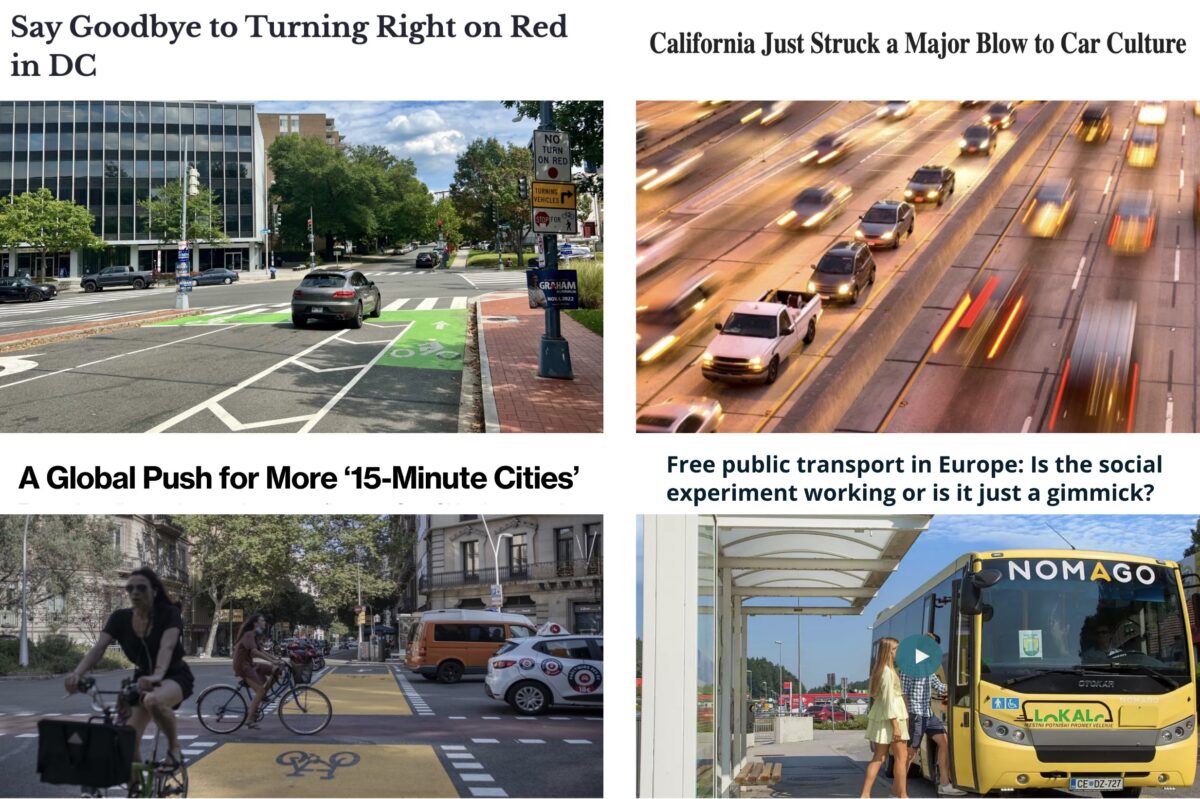
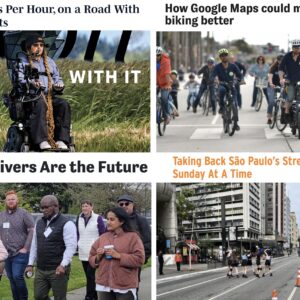
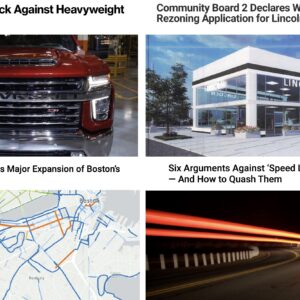
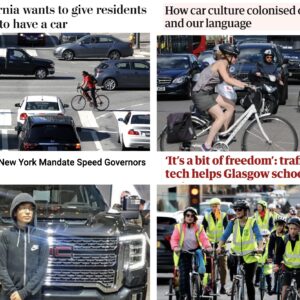
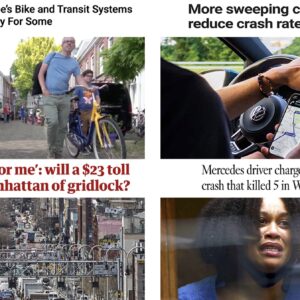
Thanks for reading.
BikePortland has served this community with independent community journalism since 2005. We rely on subscriptions from readers like you to survive. Your financial support is vital in keeping this valuable resource alive and well.
Please subscribe today to strengthen and expand our work.
Re: what to say to others out on rides. Context is everything. I ride a twenty-year-old steel LeMond. I’m used to getting compliments from people who appreciate the not-quite-vintage design. But when you come up behind me on a steep climb, pass me on a full carbon fiber, and say “nice bike,” I can’t hear it as anything but a snide comment.
When people compliment my trike I just assume it’s sincere. No reason not to. I do, however, usually limit myself to a “good morning”, “hey, perfect weather for this” or the like if I pass someone on a climb.
I think there’s a certain condescension implied by atta-boys. They have no idea if I’m working hard or Welking it. (for context see Gallagher’s bit managing traffic via music.)
I am, however, guilty of the following: While overtaking either an E-Bike or someone on the drops in full kit, I drop my right hand into my lap and (while I’m next to them) maintain my breathing at something less than what it usually is during a full FTP run :). As in “hey, look how easy this is for me”. Dumb, but what can I say?
Really? I’ve been that guy on a carbon bike passing beautiful steel bikes and giving a very well meaning compliment; I’ve never EVER meant it to be snide. I can tell you from first hand experience that keeping vintage bikes on the road is getting harder and more expensive all the time. I need a DuraAce 7100 RH brifter for my ’80’s Basso, but all I can find are used ones that may or may not work as advertised and the seller thinks is solid unobtanium and should be mounted on the queens crown as a decoration.
Many of us out here love old bikes that someone has the skill, time and patience to keep on the road.
Enjoy the compliment. You are keeping steel alive and that’s not nothin’.
Someone shouted a comliment to me about my bike on Friday- it made my day!
Snide comment? That’s your projection, probably. Not that snide comments never happen.
“scary video”. I find that that be quite common with the RFB’s and the HAWK signals. I know PBOT loves them and they can cite studies taht claim “high compliance”, but that does not match my experience. When I lived in vancouver, BC, they used half-street signals. This looks like like a standard trafic signal (green/yellow/red) tothe high traffic street, but htere is just aped head on the bike-crossing stret. The beg button triggers the yellow, then red for cars, and the ped head signals to the bike/ped that they can cross. It looks and works like any other traffic signal and people tend to obey them. THe flashing lights are ambiguous, and novel to many people. I think it is reckless to introduce something that looks and works so differnnt from traffic signals and expect it to protect the most vulnerable users. If anyone wants to test the efficacy of a RFB, try riding down Going and trigger the RFB at Basin, but please, be careful!
Regarding RFB/HAWK (and even regular traffic lights)… don’t cross until the cars have stopped.
Yes, that’s a pragmatic approach…for the vulnerable road user…that says nothing about the responsibility of those driving the autos and is a useful tool for stepping into any path where things often move, so not exactly helpful here.
I advocate for changing the RFB/HAWK lights to stop lights, and installing gates that prop up to stop any offending auto driver, like those found in high security private and government entrances. Yes, I expect neither to happen anywhere.
Drivers have a clear and unequivocal responsibility to stop, and some drivers occasionally fail to do this for one reason or another. We live in an imperfect world, so pragmatism is warranted.
Yep, always make sure they’re actually stopping (the crosswalk from the ped island to the path along 224 from 212 west/north is a classic example).
That said, I do sometimes fantasize about those big spike barriers popping up when a ped has the right of way so the many, many drivers who blow through rip their tires out.
Time to start carrying your own spike strip.
I agree, but if you think that warranted your comment, you might want to consider your possible propensity toward victim blaming. Would you have said the same if the driver killed the child? Maybe, even, the child generally practices that pragmatism, but “fail[ed] to do this for one reason or another”.
Was my statement that “drivers have a clear and unequivocal responsibility to stop” insufficiently strong? The comment I was responding to noted that drivers don’t reliably stop at RFBs and HAWKs. Shouldn’t knowing this alter a pedestrian’s behavior?
Acknowledging that there are things people can do to protect themselves against bad outcomes does not somehow absolve the party responsible for creating those outcomes. That kids are sometimes impulsive does not change anything — if a driver hits them in a crosswalk, the driver is still at fault.*
If I leave my bike unlocked and it gets stolen, the thief is still responsible even if I could have prevented the situation by locking it. I’m sure you wouldn’t blame me for the theft… would you?
*Probably.
While drivers have a legally clear and unequivocal responsibility to stop, at least in Oregon and California where the video was captured, I don’t think it is well understood. At my frequent crossing at Going and MLK I see one car stopping while another blows past at speed often and view this as mostly an education issue. I looked at both the OR and CA DMV manuals online, and this responsibly isn’t as front and center as it should be. I wish we’d have campaigns to stress that a car stopped at a crosswalk is a stop sign, period.
Furthermore, implicit when passing a car stopped at a crosswalk one is endangering a vulnerable user, rather than could be endangering some hypothetical user, and thus the penalties should be more than those for “merely” blowing a stop sign when no one is around.
I thoroughly agree. You won’t find me among those who would muddle the message by not enforcing the law. I would also absolutely support clarifying any ambiguity in the driver’s manual.
And I would educate pedestrians (especially children) to be aware of the situation and proceed cautiously.
100% agree!! I have begged PBOT to continue the bufferered bike lanes on Skdmore frmo Michigan where they end to NE 7th to take advantage of controlled intersections at Mississippi, Vancouver, Williams and MLK. PBOT insists on routing bikes AWAY from these safe crossings to follow the convoluted, hilly Going greenway with zero safe crossings. It would just take a little paint!
The scary video of the kid on a scooter is a great example of why urban streets should only have one driving lane in each direction. Urban streets aren’t highways and there isn’t a good justification to create the infrastructure that facilitates cars passing each other. This happens so often when their are 2 lanes. A car stops to let a pedestrian cross or to let another car turn left into a driveway and the driver in the other lane either doesn’t see that car is stopped, or isn’t curious why car is stopped and blows past. Road diets for all streets. Save the multi lanes for actual highways
Even worse is when it’s a 5 lane road, with two lanes in each direction, a center turn lane, and no pedestrian island or concrete divider in the middle. I had a close call with a SUV driver swerving around the TWO cars that stopped for me, and passing them in the center lane, as I was in the middle of the road. Fortunately he skidded to a stop and it looked like his passenger just started berating him for being a total idiot! Phew… More protected crossings with actual big steel poles and blocks of concrete, please.
I couldn’t agree more strongly, ROH. That passing lane is gonna be used for passing – always. What drivers CAN do they WILL do, even if it’s illegal, unsafe, or immoral.
A curious way to describe a “think-tank” (lobbying firm) funded, in part, by a trump-supporting real estate zillionaire that has had a laser focus on increasing the supply of low-density market-rate housing (e.g. RIP2 and similar laws that seek to increase the supply of single household homes only affordable by the upper classes).
PS: Anyone who says they support “abundant housing for all” and is not openly advocating for the legalization of publicly-funded 10-20 story apartment blocs everywhere is a damn liar.
Abundant housing for all (the middle and high income earners)
And a fanatical belief that housing for high income folk can somehow avoid market-based constraints on profit AND trickle-down to address the low-income housing crisis. In essence, YIMBYs who mock others for not understanding Econ 101* also often make arguments that are not support by Econ 101 demand curves.
*Anyone who describes a highly segmented housing market with non-linear demand curves in these terms is either naive or a liar.
And anyone who believes rents follow the simple rules of Econ 101 supply and demand doesn’t understand how real estate or finance works.
I think that so many of our current transportation problems are actually housing/landuse problems in disguise. And it all stems from the fact that we build suburban sprawl of single-family low-density units rather than densify. Suburban sprawl just leads to increased car dependency, more emissions, less walkable/bikeable cities, and worse public transit.
We need to make it drastically easier to build more apartments, condos, row homes, and the like in Portland itself and in inner-ring suburbs like Beaverton. Both market-rate and affordable, and via both public and private funding. No more urban growth boundary expansion.
You may be right, but the suburban sprawl is built, and there’s no going back. We need to learn how to live with it, not wish we would have built our cities differently decades ago.
The problem with building lots of new stuff in inner Portland is that there’s already something there that’s quite expensive and valuable, and which most Portlanders like a lot.
Very true; past mistakes definitely happened. But we can stop any further suburban sprawl, and work to add additional mixed-use developments within the current sprawl. It’s certainly not ideal, but we can and should work to fix our past mistakes in a methodical and organized way. Now whether or not there’s any political appetite for that currently…that’s another question 🙂
Perhaps we need to transform some of that suburban sprawl into moderately-sized cities. Market urbanists are enamored with mega-cities that can support bougie “Jane Jacobs” urban centers* but the climate literature increasingly suggests that the best (e.g. rapid) way to decarbonize land use might be to focus on mid-sized cities due to decreased scaling of emissions reduction as city size increases.
https://www.nature.com/articles/s41467-019-11184-y
*For selfish reasons that have little to do with “equity”
I think building new cities in underutilized suburban land makes much more sense than trying to raze Ladd’s Addition to build a new South Waterfront there filled with affordable housing.
Unfortunately, a prime opportunity to build a new urban center at Gateway has languished for decades.
The biggest obstacle at Gateway and many other suburban centers is a lack of land consolidation – holdout owners unwilling to sell to developers, or even to develop. It’s amazing, but some homeowners even like to live in their suburban houses with big yards – imagine that. And a reluctance by governments to use eminent domain to force land consolidation for economic development purposes – bridges and highways are fine – but apparently not huge new 20-40 story apartment blocks.
We manage to develop plenty of other areas without a single land owner.
That is a big problem, but maybe no the biggest. If Trimet had put the transit hub at 102nd/Halsey, that may have spurred some investment and redevelopemnt. Instead, they located it behind a underutilized shopping center overlooking a freeway. And we wonder why this hasn’t become a town center!?
The reason razing Ladd’s addition makes sense is that this area is fantastically well-resourced with the basic transportation and residential infrastructure needed for very high density.
So many things that make sense are; however, utterly outside the Overton window of the USAnian/Portlandian plutocratic anocracy.
Razing people’s homes and displacing them is generally outside most people’s Overton windows these days.
I agree but would stress that this problem is not solvable by a market that thrives on regulatory/government capture, financial speculation and scarcity-based profit. IMO, the only way we can reshape the way we live in any kind of a meaningful and equitable way is via massive non-market-funded transformation of how we allocate income/assets. (And this stark fact is precisely why I am so critical of “free”-market think tanks.)
I think many of these “new urbanists” would agree that public housing is good and we need much much more of it. However there is a limit set by the federal government on how much subsidized housing there can be and it would be an uphill battle to amend the Housing Act to allow for more. I don’t agree that market forces can solve housing but perhaps its the best(only) tool availble right now?
This is simply not the case given that there are multiple mechanisms by which to publicly subsidize housing. For example, the coop mechanism used in Vienna is currently legal via multiple strategies and there is absolutely no barrier to legally formalizing housing coops in OR.
Sad historical note: Comm. Eudaly attempted to begin formalize this process via her TOP ordinance but there was little support for this ordinance from the free-marketeers at Sightline and P:NW. On the other hand, lot subdivisions that would allow more single household homes only affordable to millionaires to be built was a huge priority.
Any person or group can start a housing co-op if they think it’s in their interest.
Let me guess, you want people who have easily replicable skills with little training be provided income sufficient to buy appreciating assets in the most desirable areas while bearing little to no risk? I am genuinely interested in what this would look like and who you would appoint as a more appropriate allocator of assets and income.
Food for thought on the “language matters” front: I find it disingenuous, or at least euphemistic, to say the child was “almost hit” by the car. The car did not touch her body, sure, but it did indeed hit her scooter, and caused her to fall to the ground. We don’t say a person riding a bike was “almost hit” by a car if the car clips their wheel and causes them to crash, do we? This is no “almost” as far as I’m concerned.